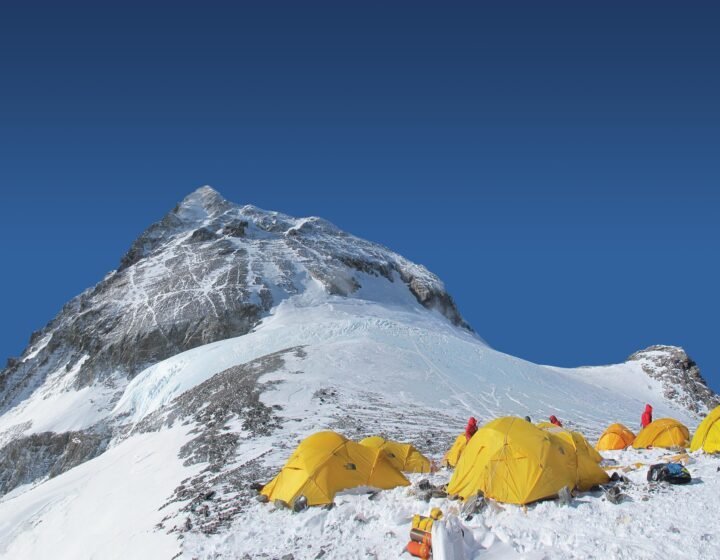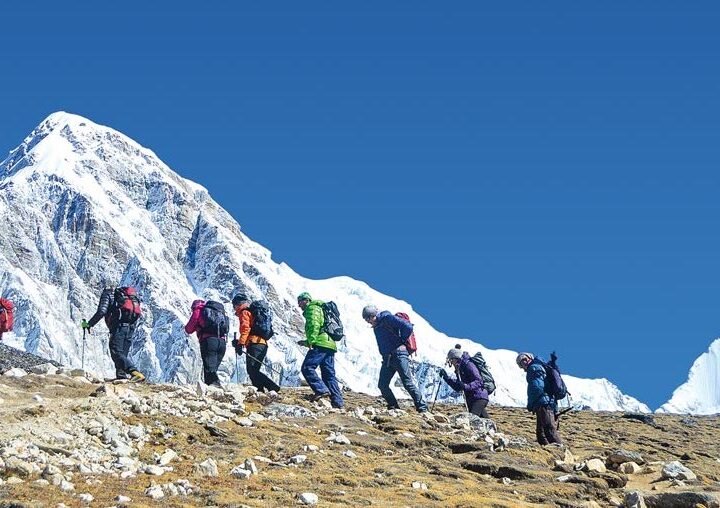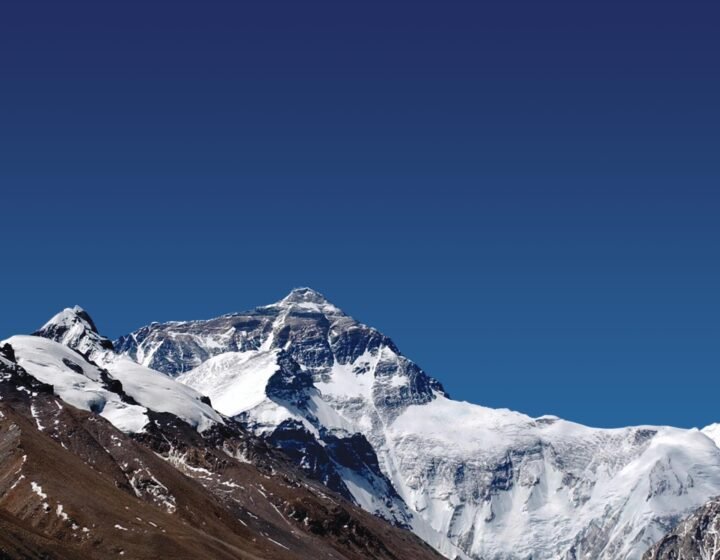- Details
Detailed itinerary
Itinerary- Tour Includes/Excludes
- Useful Info
- Trip Map
- FAQ
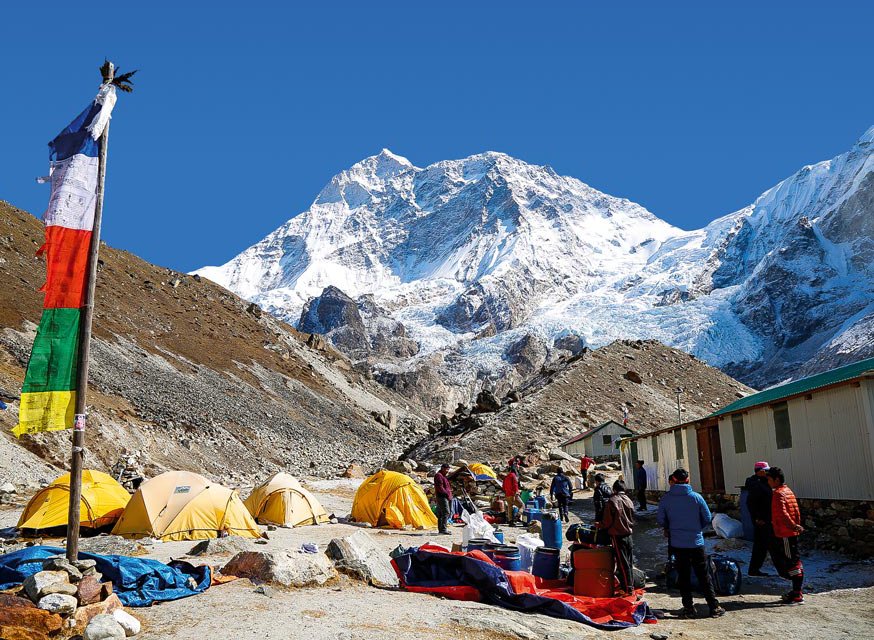
Trip overview
The Makalu Base Camp trek is a remote route that includes some of Nepal’s best features, including peaceful trails, vibrant terraced farmland, rural culture, rhododendron forests, rare wildlife, and several highest peaks. The Makalu Barun National Park is Nepal’s 8th largest national park covering 2,330 square kilometers. The spectacular views from Makalu Base Camp include the rarely-seen Kangshung face of Everest and Lhotse, Chamlang, and Kanchenjunga in the far east.
The journey to Makalu Base Camp starts with a short flight to Tumlingtar from Kathmandu. After arrival in Tumlingtar, we do 6 to 7 hours of hiking on average. The walk led us to Makalu Barun National Park. The lower parts of the trek take us through rhododendron forests, river valleys, and charming Gurung villages, while the base camp is rocky and devoid of vegetation. There are also high-altitude lakes to see, as well as the majestic mountains that surround you. This is an excellent hike for those who enjoy nature, dislike crowded trails, and are physically fit.
The national park is home to a number of endangered species, including snow leopards and red pandas. This place also provides a favorable environment for musk deer, wild boar, Himalayan goats, and wild yaks. Local Gurung and Sherpa, who mostly follow Buddhist philosophy, have kept the area in good condition.
We will cross the Shipton Pass (4,200m), named after Eric Shipton, the famous mountaineer who mapped out the famous route over Mount Everest’s Khumbu Glacier. The trail also crosses the Keke La pass, from which Peaks VI and VII can be seen. We will see the Barun Glacier on the south face of Makalu as well as an incredible view of Everest from Base Camp.
Highlights:
- Trek through Makalu Barun National Park
- Cross the Shipton Pass.
- The Red Panda, high-altitude lakes, emerald woodland, and majestic mountains.
- Actual Nepalese Rai and Sherpa experience.
- A glimpse of Kangshung and a unique angle of Mt. Everest.
Itinerary
Day 01: Arrival in KathmanduAt Tribhuvan International Airport, we pick you up and deliver you to your hotel in Kathmandu. Overnight at the finest hotel in Kathmandu.
Our private van takes us to UNESCO World Heritage Sites in Kathmandu. The Buddhist stupa of Swayambhunath, often referred to as the Monkey Temple, will be our first stop. From Swayambhunath's summit, one can get a broad vista of Kathmandu. The next stop is Pashupatinath, a Hindu temple, and the next stop is Boudhanath, a Buddhist stupa. In Boudhanath, there are several restaurants to satisfy your appetite. Spend the night in Kathmandu at a four-star hotel.
We kick off our journey with an early morning flight to Tumlingtar. We reach Tumlingtar, where we rest over night and enjoy a breathtaking view of the mountains, hills, and rivers that make up the Nepalese scenery.
By crossing the Makalu Barun Conservation Area, we continue our journey to Seduwa. The trial is full of dense forests of juniper and rhododendron, and small hamlets.
We trek across Isuwa Khola and Kusuwa Khola on opposite sides, passing through various small settlements and woodlands as we cross Isuwa Khola on a wooden bridge. We arrive in the Sherpa village of Tashigaon after a couple of hours of trekking and after passing under the bridge. The view of the Himalayas from Tashigaon is stunning. We spend the night at the lodge of Tashigaon.
We could have a tough day today as we make our way to Khongma Danda by hiking up high hills. A few lakes and pastures with yaks, blue sheep, and other Himalayan cattle grazing in them are visible as we ascend stone steps. We enter Makalu Barun National Park when we get to Unshisa. Our 7-hour hike brings us to Khongma Danda. For one night, we stay at the guest house of Khongma Danda.
At a high altitude, you need time to adapt to the unique environment. Today, we will take a break from our walk. Later, we can explore some nearby Buddhist monasteries and talk to the locals to learn about Sherpas' culture and way of life. Spend the night at a lodge in Khongma Danda.
We have four passes to cross in order to get to Dobate, so it will be a challenging day for us. We begin by ascending over Kauma La Pass (3603m), and after that, we continue to Keke La Pass (4127m). We continue to ascend until we reach the Shipton La pass (4170m), where we come across the stunning Kalo Pokhari Lake. Then, after a couple of hours of hiking and passing via the Tutu La Pass (4080m), we arrive at Dobate. From Dobate, we get enticing views of the other Himalayas as well as Chamlang (7319m), Peak 6 (6524m), and Peak 7 (6758m). for the night at a lodge in Dobate.
We hike towards Yangri Kharka while passing through thick rhododendron trees and crossing the Barun River. Yaks may be grazing in the field as we travel. Yaks are the main mode of transportation in these areas. After a seven-hour hike, we arrived at Yangri Kharka. a lodge in Yangri Kharka for the night.
To get to Merek, we go through dense Himalayan forests and pass a few wooden bridges over tiny creeks. To get to Langmale Kharka, we continue our hike while pursuing the beautiful Himalayan panorama, traveling on moraines and passing by tiny Himalayan towns. a lodge in Langmale Kharka for the night.
We hiked up a treacherous trail next to Barun Nadi and across freezing glaciers and hills to get to Shershong. On our trip to the base camp, we take in the splendor of Mt. Makalu's (8481m) magnificence. We hike for about an hour or so before arriving at Makalu Base Camp. From base camp, the view of the Himalayas is breathtaking. At a lodge in Makalu Base Camp for the night.
Today, we explore the area around Makalu Base Camp while enjoying a stunning view of the Himalayas in eastern Nepal, including Everest (8848m), Lhotse (8516m), and Makalu from the south face. We enjoy the nearby glaciers' and lakes' natural splendor. We can also take a short detour to the serene Barun Pokhari while ascending to the Barun Glacier. At a lodge in Makalu Base Camp for the night.
We wished the Makalu Base Camp good night after completing our journey successfully, and we then descended to Yangri Kharka. On our way to Yangri Kharka, we pass the little towns of Shershong, Langmale Kharka, and Merek as we go through scant forests along steep trails. a lodge in Yangri Kharka for the night.
To get to Dobate, we go along the freely flowing Barun River, passing through alpine woods, rocky peaks, and a few minor streams. As we make our way to Dobate, we take in the splendor of nature. We might encounter yaks, snowbirds, and blue sheep along the way. for the night at a lodge in Dobate.
We depart Dobate today for Khongma Danda. To get to Mumbuk, we hike through fir, juniper, and rhododendron forests. After a 7-hour journey from Mumbuk, we pass through the passes of Tutu La (4080 m), Shipton La (4170 m), Keke La (4127 m), and Kauma La (3603 m) before arriving at Khongma Danda. Spend the night at a lodge in Khongma Danda.
On our journey back to Tashigaon, we hike through extensive forests and past a number of lakes. We leave the Makalu Barun National Park and hike for five hours before reaching the picturesque Sherpa settlement of Tashigaon. Tashigaon lodge for the night.
We trek along little streams as we pass through quaint towns and the barren Barun River valley. We arrive in Seduwa after 5 hours of walking, with Isuwa Khola on one side and Hingsa Khola on the other. Seduwa lodge for the night.
As we leave the Makalu Barun Conservation Area, we hike through a number of lush rhododendron and bamboo woods and cross the Arun River. We pass through a small Sherpa village in the countryside on our way to Num. Then, after a couple of hours of walking, we arrive at the Sherpa settlement of Num. Spend the night in Num at a lodge.
The last day of our adventure is today. We have the privilege of hiking in difficult terrain before arriving in Tumlingtar, while taking in the stunning view of Mt. Makalu (8481m). We arrive in Tumlingtar after a seven-hour hike. Tumlingtar lodge for the night.
After a successful trek, we fly back to the city while taking in the stunning mountain scenery. Feel free to do whatever you want with your free time.
We farewell and drop you off at Tribhuvan International Airport.
Included
- Private vehicle-based airport pickup and drop-off in Kathmandu.
- The welcome and farewell dinners include the cultural programs noted in the schedule.
- B/B hotel accommodations in Pokhara and Kathmandu that meet tourist standards.
- The itinerary-specified half-day guided city tour with a world heritage entrance permit.
- Private transportation to and from the trek's beginning and end locations.
- Twin-sharing lodging in a standard lodge or guest house during the journey, if available.
- Three meals per day of full board service while on the hike.
- Fees for the Trekker's Information Management System (TIMS) card and the trekking permit.
- A certified local trekking guide who holds a government license.
- All costs incurred by the staff (guides and porters), including food, lodging, wages, insurance, and equipment throughout your trip.
- All of the necessary hiking equipment for porters, such as a jacket and pants, hiking boots, gloves, shocks, and sunglasses.
- A complete first-aid kit.
- Promptly set up every rescue and evacuation in Worst Condition
- Gear for group treks.
- Trekking Map, a unique souvenir from the Travel bureau of Nepal agency.
Not Included
- All pre-packaged foods and snacks, aerated beverages, energy drinks, mineral water, alcohol, cigarettes, chocolates, and nutria bars.
- All sweets, including pudding, cake, pie, and chocolate.
- Personal items, laundry costs, and tips.
- Clothes, packing supplies, a personal medical kit, and personal trekking equipment.
- Any additional personnel not otherwise mentioned.
- Medical and travel insurance, as well as, if necessary, emergency transportation by any means, including helicopter evacuation.
- The costs of hospitalization, medicine, medical exams, and repatriation.
- The cost of overseas airfare.
- Fee for admission into Nepal (Visa issuance is easy at the arrival).
- Battery charging and hot showers in the tea houses.
Useful Info
- When booking and arriving, all foreign travelers must provide their personal information, including passport and visa information.
- Expect none of the trekkers to pack anything that won't decompose.
- Intoxicating substances and alcohol consumption are fully forbidden during trekking
- Advice to retain a buffer day to handle uncertain events.
- It is a must for all travelers to maintain their passports or visa with travel agencies.
- There is a larger risk of becoming dehydrated, so drink plenty of water regularly and carry additional bottles with you.
- When hiking at a higher altitude, layering your clothing is the greatest approach to regulating your body temperature. Therefore, zippered clothing is the ideal choice.
- Because mobile phone and camera batteries have a high likelihood of going dead or losing power quickly, a portable charger is essential for your electronic devices.
Trip Map
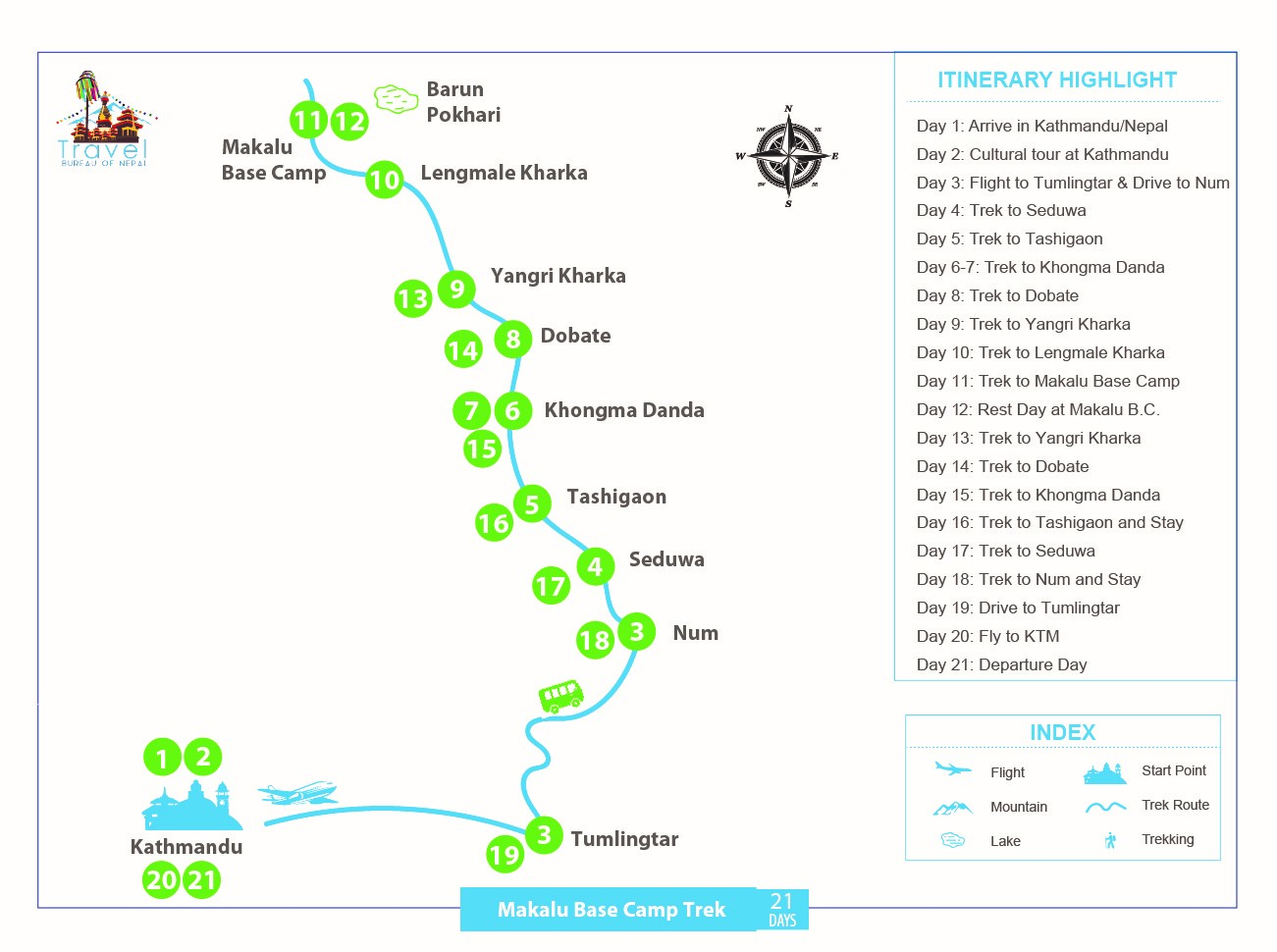
FAQs
-
Is a permit required for the Makalu Base camp trek?
Yes, there are two types of permits in general. First Makalu Barun National Park Permit (the US $30 per person) the and other is TIMS permits for trekking in the Makalu region(US $20 per person)
-
Where is Mt. Makalu located?
Mt. Makalu (8485m) is located southeast of Mt. Everest on the Nepal-Tibet border. Mt Makalu is the sixth highest peak in the world.
-
When is the best season for the Makalu Base camp trek?
The best seasons for the Makalu Base Camp trek are spring (March-May) and fall (September-November) (September-November). The weather has remained pleasant, with temperatures remaining mild (particularly at low and mid-elevations). The Makalu circuit walk is feasible in the winter, but the extreme temperatures may be too much for the region's lodges, which aren't particularly well equipped.

